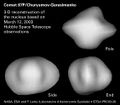Astronomy:2009 WM1
| Discovery[1] | |
|---|---|
| Discovered by | Catalina Sky Survey (703) 0.68-m Schmidt |
| Discovery date | 2009 Nov 17 |
| Designations | |
| 2009 WM1 | |
| Minor planet category | Apollo NEO, PHA[2] |
| Orbital characteristics[2] | |
| Epoch 13 January 2016 (JD 2457400.5) | |
| Uncertainty parameter 0 | |
| Observation arc | 1642 days (4.50 yr) |
| |{{{apsis}}}|helion}} | 1.3801 astronomical unit|AU (206.46 Gm) (Q) |
| |{{{apsis}}}|helion}} | 0.98103 AU (146.760 Gm) (q) |
| 1.1806 AU (176.62 Gm) (a) | |
| Eccentricity | 0.16902 (e) |
| Orbital period | 1.28 yr (468.53 d) |
| Mean anomaly | 302.65° (M) |
| Mean motion | 0° 46m 6.096s /day (n) |
| Inclination | 25.765° (i) |
| Longitude of ascending node | 240.28° (Ω) |
| 162.58° (ω) | |
| Earth MOID | 0.000480406 AU (71,867.7 km) |
| Jupiter MOID | 3.98384 AU (595.974 Gm) |
| Physical characteristics | |
| Dimensions | ~280 metres (920 ft)[3] |
| Mass | 2.9×1010 kg[3] |
| Absolute magnitude (H) | 20.4[2] |
2009 WM1 is an Apollo near-Earth asteroid[4] that is estimated to be 280 metres in diameter with an estimated mass of 2.9×1010 kg.[3] When the asteroid was first discovered for about a month it was briefly listed at a Torino Scale of 1 and a cumulative Palermo Scale of −0.87.[3] It was removed from the Sentry Risk Table on 26 June 2013.[5] 2009 WM1 will pass 0.0046 astronomical unit|AU (690,000 km; 430,000 mi) from Earth on 2059-Nov-23.[6]
Even though 2009 WM1 has an Earth MOID of 0.00009 AU (13,000 km; 8,400 mi), the orbit and future close approaches are well determined with an orbital uncertainty of 1.[2] 2009 WM1 will pass Earth at a distance of 0.0005 astronomical unit|AU (75,000 km; 46,000 mi) to 0.069AU on 2199-Nov-23,[6] but since it is a close approach and the exact distance in uncertain, future close approaches after 2199 are uncertain.
2014 passage
The 21 May 2014 Earth close approach of 0.3622 AU (54,180,000 km; 33,670,000 mi) should allow a refinement to the orbit.[6] From 7 May 2014 until 2 June 2014 the asteroid will be brighter than apparent magnitude 20.[7] The asteroid will come to opposition on 18 May 2014 when it will be up all night.[7]
References
- ↑ "MPEC 2009-W30 : 2009 WM1". IAU Minor Planet Center. 2009-11-18. http://www.minorplanetcenter.net/mpec/K09/K09W30.html. Retrieved 2012-06-26. (K09W01M)
- ↑ 2.0 2.1 2.2 2.3 "JPL Small-Body Database Browser: (2009 WM1)". Jet Propulsion Laboratory. http://ssd.jpl.nasa.gov/sbdb.cgi?sstr=2009WM1;cad=1. Retrieved 2013-01-31.
- ↑ 3.0 3.1 3.2 3.3 "Earth Impact Risk Summary: 2009 WM1". Wayback Machine: NASA/JPL Near-Earth Object Program Office. Archived from the original on November 27, 2009. https://web.archive.org/web/20091127152621/http://neo.jpl.nasa.gov/risk/2009wm1.html. Retrieved 2013-07-27.
- ↑ smallbodies 13:52 9.10.11
- ↑ "Date/Time Removed". NASA/JPL Near-Earth Object Program Office. http://neo.jpl.nasa.gov/risk/removed.html. Retrieved 2013-09-02.
- ↑ 6.0 6.1 6.2 "JPL Close-Approach Data: (2009 WM1)". http://ssd.jpl.nasa.gov/sbdb.cgi?sstr=2009WM1;cad=1#cad. Retrieved 2013-01-31.
- ↑ 7.0 7.1 "2009WM1 Ephemerides for 1 May 2014 through 15 June 2014". NEODyS (Near Earth Objects – Dynamic Site). http://newton.dm.unipi.it/neodys/index.php?pc=1.1.3.1&n=2009WM1&oc=500&y0=2014&m0=5&d0=1&h0=0&mi0=0&y1=2014&m1=6&d1=15&h1=0&mi1=0&ti=1.0&tiu=days. Retrieved 2014-02-01.
External links
- 2009 WM1 at the JPL Small-Body Database




